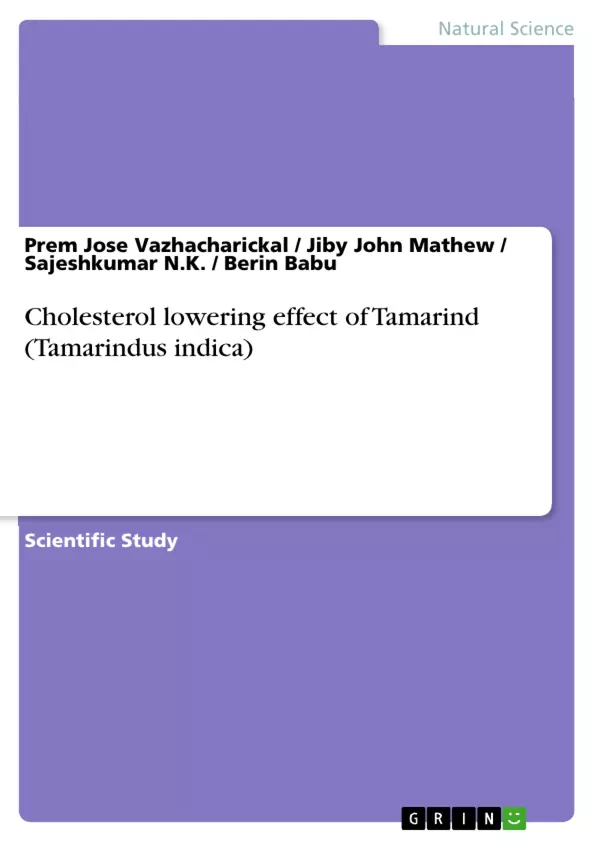Aqueous extract of the fruit pulp of Tamarind (Tamarindus indica) were evaluated for cholesterol lowering effect, in vitro, against various fatty food materials. People consume food items made by chicken, beef, mutton, egg and fish and it contains large amount of fat. This study aims to analyze the effect of Tamarindus indica in reducing the cholesterol level in this fat compound using water extract of the pulp.
For this fatty food samples like egg yolk, pork fat, chicken fat, ghee and cod liver oil were treated with the extract and cholesterol level was estimated by Zak’s method for a period of time. Phytochemical constituents present in water extract of Tamarindus indica pulp includes Alkaloids, saponins, steroids, phlobatannins, carbohydrate, terpenoids, phenols, coumarins and leucoanthocyanins. The in vitro cholesterol lowering effect of Tamarindus indica pulp extract shows a positive result on chicken fat, ghee and egg yolk. But in case of pork fat and cod liver oil no beneficial change was observed.
Inhaltsverzeichnis (Table of Contents)
- Table of contents
- Table of figures
- Table of tables
- List of abbreviations
- Cholesterol lowering effect of Tamarind (Tamarindus indica): a brief overview
- Abstract
- Introduction
- Objectives
- Review of literature
- Hypothesis
- Materials and Methods
- Study area
- Collection of plant material
- Preparation of Tamarindus indica fruit pulp extracts
- Phytochemical screening
- Test for alkaloids
- Test for anthraquinones
- Test for anthocyanins
- Test for carbohydrate
- Test for coumarins
- Test for emodins
- Test for flavonoids
- Test for glycosides
- Test for leucoanthocyanins
- Test for phlobatannins
- Test for proteins
- Test for phenols
- Test for saponins
- Test for steroids
- Test for terpenoids
- Preparation of cholesterol samples
- Treatment
- Estimation of cholesterol
- Statistical analysis
- Results and discussion
- Conclusions
- Acknowledgements
- References
Zielsetzung und Themenschwerpunkte (Objectives and Key Themes)
The study investigates the potential of Tamarind (Tamarindus indica) fruit pulp extract as a cholesterol-lowering agent. The primary objective is to evaluate the phytochemical properties of the extract and determine its in vitro cholesterol-lowering effect on various fatty food materials. This study focuses on the potential of Tamarind as a natural alternative for managing cholesterol levels, contributing to a healthier lifestyle.
- Phytochemical analysis of Tamarind fruit pulp extract.
- In vitro cholesterol-lowering effect of Tamarind extract on various fatty food materials.
- Potential application of Tamarind as a natural cholesterol-lowering agent.
- Exploring the phytochemical constituents responsible for cholesterol reduction.
- Comparing the effectiveness of Tamarind extract on different types of fat.
Zusammenfassung der Kapitel (Chapter Summaries)
- Introduction: This chapter introduces Tamarind (Tamarindus indica) as a medicinal plant with a long history of use. It highlights the importance of cholesterol management and the increasing need for natural, less toxic options for treating hyperlipidemia.
- Review of Literature: This chapter provides a comprehensive overview of the scientific literature on Tamarind, including its traditional medicinal uses, phytochemical composition, and reported health benefits. It emphasizes the potential of Tamarind in lowering cholesterol and triglycerides.
- Materials and Methods: This chapter details the methodology used in the study, including the collection of Tamarind fruit pulp, preparation of the extract, phytochemical screening, and cholesterol estimation techniques. The chapter also describes the statistical methods used to analyze the data.
- Results and Discussion: This chapter presents the results of the phytochemical analysis and the in vitro cholesterol-lowering effect of Tamarind extract on different fatty food materials. It discusses the potential of specific phytochemical constituents in reducing cholesterol levels.
Schlüsselwörter (Keywords)
The main keywords and focus topics of this study include Tamarindus indica, cholesterol, phytochemicals, hyperlipidemia, in vitro analysis, fatty food materials, and natural cholesterol-lowering agent. This research explores the potential of Tamarind as a natural alternative to conventional drugs for managing cholesterol levels, focusing on the identification of specific phytochemicals and their mechanisms of action.
- Quote paper
- Dr. Prem Jose Vazhacharickal (Author), Jiby John Mathew (Author), Sajeshkumar N.K. (Author), Berin Babu (Author), 2017, Cholesterol lowering effect of Tamarind (Tamarindus indica), Munich, GRIN Verlag, https://www.hausarbeiten.de/document/369797


